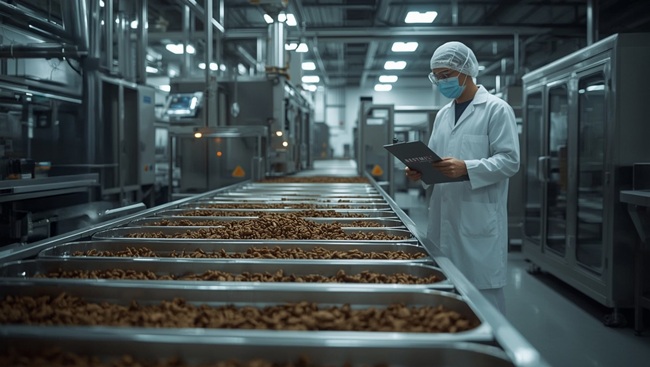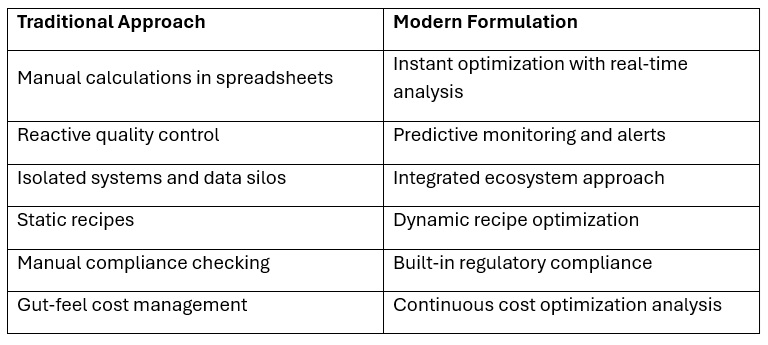
What keeps pet food professionals up at 2 AM? It’s not just Salmonella, ingredient shortages, or missed deliveries. It’s the rising pressure from a new generation of pet owners who expect perfection and demand it fast.
Brand Insights from Bestmix
The Bottom Line: Young pet parents are investing significantly in premium pet food because they genuinely want the best for their pets - much like they would for their children. They're willing to spend time understanding what really matters at every stage of their pet's life and can quickly identify which products and brands meet those needs thanks to their proactive use of modern platforms and technologies. This creates unprecedented pressure on product developers, formulators, and QC managers to deliver perfect products faster than ever. The secret? Not more hours. Not more people. It's in doing things differently. Let's explore what's making the biggest impact.
The 2 AM formula crisis
Sarah Chen was staring at her computer screen at 11:47 PM, spreadsheet formulas reflecting off her glasses. As the lead product developer for a growing premium pet food company, she'd been wrestling with the same nightmare for weeks: how to reformulate their bestselling grain-free dog food to keep up with Gen Z pet parents who wanted everything — transparency, sustainability, personalized nutrition, while keeping the exact nutritional profile that made their product amazing.
The numbers on her screen told a story that's becoming way too common in pet food. According to the American Pet Products Association's 2024 National Pet Owners Survey, Gen Z made up 20% of pet-owning households — that's a massive 43.5% jump from 2023. The same APPA data reveals that 70% of Gen Z pet owners have multiple pets, and they're discovering products through TikTok, YouTube, and Instagram instead of traditional channels.
But here's what all those fancy market reports don't tell you: the crushing weight that lands on professionals like Sarah. Every formula tweak, every ingredient swap, every quality decision carries the weight of pet health, brand reputation, and — let's be real — potential social media disasters.
When everyone wants everything
The pet food industry hit a breaking point. According to APPA's 2024 industry statistics, the US pet industry reached $152 billion in sales in 2024, with pet food grabbing $65.8 billion of that pie. Sounds great, right? But behind these impressive numbers is a messier reality for the people actually making these products happen.
Take Mark Rodriguez, a quality control specialist with 15 years under his belt. His company recently launched a "premium transparency" line targeting millennials and Gen Z consumers who want to know exactly where every ingredient comes from and how it affects their pets. Suddenly, the old-school approach of batch testing and standard quality checks feels totally inadequate when consumers expect real-time ingredient tracking and personalized nutrition advice.
"We're not just product developers anymore," Sarah says. "We're nutritional detectives, supply chain investigators, and brand protectors all rolled into one. And everyone expects us to do it all faster than ever."
The formulation nightmare
Here's the thing about being a modern pet food formulator — you're stuck in this crazy paradox. You need to think about digestibility, shelf life, regulatory stuff, ingredient selection, processing tweaks, and making sure pets actually want to eat the food. But the market wants everything yesterday, and traditional formulation methods just can't keep up.
The biggest challenge? Making sure pets get proper nutrition. Each species has specific needs, plus you've got to consider age, size, breed, and health conditions. It's like solving a puzzle where the pieces keep changing shape.
This gets even more complicated when you factor in the premium pet food boom. According to market research from Grand View Research, premium products are seeing double-digit growth while other categories are struggling. Everyone wants in on that action.
But here's what keeps professionals up at night: nailing the formula is only half the battle. The other half? Making sure you've got all the right raw materials with correct nutritional specs, running multiple quality checks, adjusting formulas on the fly when ingredients vary, creating accurate labels, and somehow staying profitable while meeting premium expectations.
QC Chaos: A day in the life

Our quality control manager Mark puts it perfectly: "I wake up to emails about ingredient delays, regulatory changes, and customer complaints. By lunch, I'm juggling three different formula adjustments, two supplier audits, and a crisis meeting about a batch that's slightly off. By evening, I'm trying to predict how supply chain chaos will mess with next month's production."
The industry's biggest headaches? Oxidation, mycotoxins, foreign materials, Salmonella control, peroxide values, stability issues, inflation, and a bunch of other stuff. These aren't just technical problems, they're daily realities that affect every single decision.
The stakes couldn't be higher. Bad pet food can literally make pets sick and cause lasting damage to a brand’s reputation. Critical quality checks are not optional, they’re essential. Since humans and animals live so closely together, pet food safety is absolutely crucial. Yet professionals are expected to handle all this while also meeting the speed and transparency demands of modern consumers.
The technology bridge
The most successful pet food pros get it expertise alone isn't enough anymore. You need tools that can match your knowledge with the speed and precision that modern pet food production demands.
This is where smart formulation software stops being nice-to-have and becomes absolutely essential. Remember Sarah's midnight crisis? What if instead of manually calculating nutritional adjustments across dozens of spreadsheets, she had access to tools that could instantly model different ingredient scenarios, predict cost impacts, and ensure regulatory compliance?
Must-have components of modern formulation software:

Our recent white paper on how AI is transforming pet food production reveals how leading manufacturers are staying ahead with comprehensive formulation systems that include:
- Smart Ingredient Selection: Real-time analysis of what's available, cost changes, and nutritional variations
- Dynamic Recipe Optimization: Instant adjustments based on changing parameters while keeping nutrition intact
- Integrated Quality Control: Automated tracking of critical points throughout production
- Regulatory Compliance: Built-in checks for AAFCO, FEDIAF, and other requirements
- Cost Optimization: Continuous analysis of ingredient costs and profitability impact
- Traceability Systems: Complete ingredient tracking from supplier to finished product
The "label once, comply always" approach we detailed recently becomes crucial when you're dealing with multiple product lines, changing regulations, and demanding consumers who expect transparency.
Why people still matter more than tech
Here's the thing: technology doesn't replace skilled nutritionists, formulators, and quality control professionals. It makes them superhuman. The most successful pet food companies get this distinction and invest in tools that empower their teams instead of trying to replace them.
Pet food development needs a team of highly trained nutrition professionals. These people bring irreplaceable expertise in animal nutrition, ingredient interactions, processing effects, and food safety. What they need are tools that can keep up with their knowledge and the market's crazy demands.
Take the success story we documented with About Petfood's premium consulting approach using BESTMIX® Recipe Management. It shows how the right technology amplifies human expertise rather than replacing it.
What's next?
The pet food industry is at a crossroads. Gen Z represents a massive opportunity for manufacturers and retailers. They love online shopping and they're driving growth in niche categories. Meeting their demands requires more than good intentions: it requires the right mix of human expertise and technological capability.
For product developers like Sarah and quality control pros like Mark, the future isn't about choosing between traditional expertise and modern technology. It's about finding the right tools that can match their knowledge with the speed and precision that today's market demands.
The companies that'll crush it in this new landscape are those that empower their professionals with comprehensive formulation and quality control systems. Because in an industry where every decision affects pet health and brand reputation, having the right tools isn't just nice — it's absolutely necessary.
The hidden heroes of the pet food industry deserve the best tools to match their expertise. The real question is whether technology will transform pet food formulation and quality control or if your team will be ready to lead that transformation.
Your team doesn't need more stress. It needs smarter systems. Discover how leading professionals are using tech to stay ahead, safeguard quality, and reclaim their time.
Learn more about comprehensive solutions that empower teams to deliver exceptional results.
